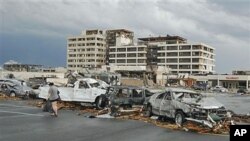Authorities in the midwestern U.S. state of Missouri now say at least 116 people are dead after a powerful tornado ripped through the city of Joplin, reducing much of the area to rubble.
Weather officials say the twister may have been the deadliest single tornado in the United States in nearly 60 years. The powerful weather system that spawned it struck the Joplin area Sunday evening, crushing cars in its path, uprooting trees and ripping apart homes and businesses.
Sirens gave city residents a 24-minute warning to seek safety before the twister touched down. The tornado also damaged a hospital, which was evacuated, and left a helicopter crushed on its side in the hospital parking lot.
|
Tornadoes at a Glance |
|
Formation: Rotating thunderstorms or supercells cause the most destructive and deadly tornadoes. Many supercells never produce a tornado. They can produce damaging hail, extreme winds, frequent lightning, flash floods and can last for many hours. |
|
Duration: Tornadoes can last from several seconds to more than an hour. Most last less than 10 minutes. |
|
Damage: The new, Enhanced F-scale is becoming the standard for assessing tornado damage. Even with engineering guidelines, tornado wind speeds are based on calculations. |
|
Frequency: About 1,300 tornadoes strike the U.S. each year. The true average is not known due to recording mistakes, erroneous classification or under reporting. |
|
Path: Most tornadoes move from southwest to northeast, or west to east. Some change direction or even backtrack. |
|
Prediction: One or two days in advance, forecasters look for temperature and wind flow patterns which can cause enough moisture, instability, lift and wind shear for tornadic thunderstorms. |
| Source: National Oceanic and Atmospheric Administration |
Search crews in Joplin labored Monday to find tornado victims, but their effort was made more difficult by a thunderstorm and driving rain in the area. Officials estimate the tornado damage covers at least 25 percent of Joplin, a city of about 50,000 people. Its wind speed was reported at 265 kilometers per hour.
Missouri Governor Jay Nixon Monday went to the areas hit by the storm to survey the damage and meet with emergency personnel. A statement issued by his office says the Federal Emergency Management Agency has extended disaster assistance to individuals and families in the counties that bore the brunt of the storm.
U.S. President Barack Obama called the governor to express condolences and pledge federal government support for recovery efforts.
Separately, another tornado in the northern state of Minnesota killed one person and injured nearly 30 others. The strong line of storms swept across states stretching from Wisconsin to Oklahoma.
Last month, tornadoes and violent thunderstorms killed more than 300 people across the southern United States. Alabama bore the brunt of the fatalities, with more than 200 dead.
In the southern state of Louisiana, the U.S. Coast Guard has reopened a stretch of the Mississippi River near Baton Rouge after the section was closed when three barges sank amid high water and fast currents. Officials are allowing the barges to move north through that section of the river.
Earlier this month, U.S. Army engineers opened a spillway north of Baton Rouge in an effort to save that city and New Orleans from the flood waters of the Mississippi. The flooding was caused by snow melt and heavy rains in northern states, and it was carried south by the Mississippi and its tributaries.
Some information for this report was provided by AP and Reuters.












